Reviews
PES 2013
September 23, 2012, Author: Phil Ubee
There are certain things that are synonymous with Autumn; blackberries, leaves falling from the trees, the heating going on for the first time since Easter, and the release of big video-game sporting franchises. This year, Konami have given us PES 2013 a little earlier than usual, perhaps to get a head start on their big rival in that all-important battle for supremacy.
I, like many journalists, was fortunate enough to receive the review copy of the game in advance of release with a view to giving you, our beloved reader, the low down before the game hit the high street on Friday 21st September. However, Konami decided that they were not going to enable the servers to allow online play until that date so, unlike many of our larger more professional peers, we made the decision to delay posting our review until this part of the game could be fully tested. This enables us to give you all the facts.
So to coin a phrase, does PES 2013 “hit the ground running?” Read on to find out.
Kick-off
There are, as ever, a number of game modes to this year’s version. Standard exhibition matches are available alongside officially licensed versions of the European Champions League and its South American equivalent, the Copa Libertadores. Elsewhere you can compete in an international cup competition or take part in one of the game’s pre-set online competitions. In addition to these we have the returning Football Life section which is where you will find the Become a Legend, Master League and Master League Online modes.
Become a Legend is where you play out the career of an individual player and try to elevate yourself to greatness on the pitch. You have the option of putting yourself into the body of any of the existing players in your favourite side to shape their career, or creating a player yourself. When choosing to create a player you set your name, nationality, appearance and position before having the option to slightly adjust your base ratings. You’re then placed into a fairly poor side at a small club outside of the top division, and have to prove yourself worthy of a move to one of the big boys with your performances on the field.
In between games your coach will have what look like clandestine meetings with you in a corridor somewhere inside the stadium, and wastes no time in telling you how to try and engineer a move away from the club you’ve recently been signed for. On the pitch, the default view switches to behind the goal and zooms in slightly on your player which makes it harder than usual to have a picture of the field around you. To compensate, holding the Left Trigger button zooms the view out. I have found this a little unnatural to say the least and believe it makes it harder to pick passes to your team mates. Fortunately, this can be adjusted through the pause menu.
I’ll talk about the Online version later, but the Master League is the franchise’s answer to a Career mode and lets you pick any club side in the game to manage. You choose whether to compete in the European or South American section and whether to start with the club’s current squad of players or a default set. My own personal view is that a large part of what makes the Master League enjoyable is doing the latter and having to earn every single player at the club.
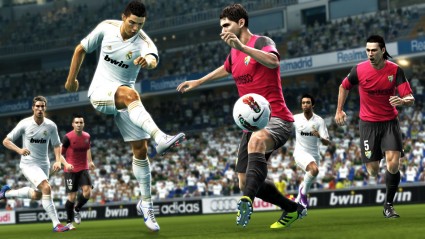
That boy Ronaldo...
The names of the default players have changed this year but the individual player ratings are the same as always, so fans of the series can identify with their favourites. You’ll start with a pretty tight budget that can be bolstered by selling some of these players (assuming someone wants to buy them) and by your performances on the pitch. The better you do, the bigger the crowd and the greater the home game income, and your sponsors will also provide you with a win a bonus. This money will allow you to negotiate for new talent to try and move your club forward, though not everyone will want to play for you until you start winning matches.
In addition to the cash, your performances will also earn you GP which is an alternate currency that lets you purchase items. These can take the form of training or performance boosts and can be attached to your players to give them a helping hand out on the field. You might also earn some items such as boots that can be equipped for an additional performance boost.
A game of two halves
So far, so PES; here is where it gets interesting. Out on the pitch, PES 2013 has seen the biggest upgrade certainly of this generation, if not ever. The refinement of the team-mate control is a small but significant factor in this, as the ability to make one of your colleagues make a run entirely of your own doing feels a little more responsive this time round. It is still a fine art controlling two different players, one on each of the analogue sticks at the same time (kind of like rubbing your tummy while patting your head), but perseverance and practice is rewarded as the game opens up to a new level when you can get this right.
On top of this the manual passing has had a bit of a face lift, which again is designed to give you more control. Holding the LT button brings a white arrow in front of your player which is directed by the left stick; this pinpoints the direction of the pass or shot and is so much easier to utilise than the previous manual passing efforts. Again, despite being easy to use it’s not so easy to master but, as with the team mate control, practice makes perfect. It also opens the game up even more, as you can perform those deft reverse passes on the edge of your opponent’s penalty area to open up stubborn defences. When this is mixed with the team mate control, the game becomes an absolute master class.
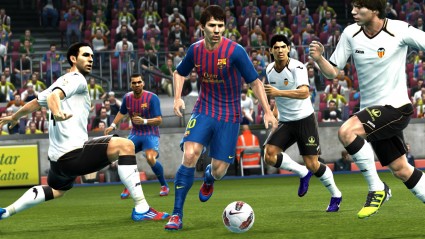
Starting to get a bit Messi
The final piece of the playing jigsaw comes in the form of the AI of your CPU-controlled players. One of my biggest criticisms of the series has been the inability of your team-mates to run past you as the ball carrier, as if some sort of invisible barrier has been on the field, held by you, that makes players just stop as they run into it. This year that has changed and not before time. What’s more is that this AI is balanced so that the poorer players do it less often and to less effect, with their runs being more basic straight lines and occasionally leading you into blind alleys.
Despite all this praise, though, there are still one or two little niggles that I have to mention. The first is that there is still no button to jostle for aerial challenges. Instead, winning headers is all about getting to the flight of the ball and accepting that you can’t win every header, even if you are seven feet tall. I’m okay with that as a realistic addition, but when you use the defensive press buttons in pursuit of a player you will put an arm out to jostle and try to use upper body strength to affect possession of the ball; so why not for an aerial challenge?
My other major gripe is with the way players run with the ball, in that even the rubbish players sprint with the ball very close to their body. You can force a heavy touch by tapping the sprint button rather than holding it, and this will actually allow you to run faster than when you’re dribbling. However, with so many other aspects of the players’ animations, not least the first touch seeing an added dose of realism (which will see the ball bouncing back off of you into the path of your opponent if you’re not careful), it’s a bit of a let-down to see this aspect is the same as it was four or five years ago.
He worked his socks off
Visually, PES is something of a mixed bag. Firstly, the menus have a pretty basic overall look and feel to them and in all honesty haven’t moved on for about three years in style, but then again they are only menus. However, this continues into the Master League and Become A Legend modes where the pre and post-game conversations with club officials are, for want of a better word, rubbish. The animated sequences look as though they have been lifted from a sixties newspaper comic strip and put together in the same way, with no real action taking place bar some non-existent lip synching or a few lines going up on a whiteboard.
The other big negative is with the general detail in the player’s faces, which is just not as sharp as you’d like or expect it to be with where we are in the console cycle. In my opinion this actually gives the game a slightly arcadey feel.
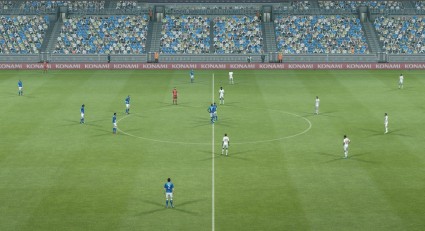
We do our talking on the pitch
On the flip-side, the stadia are brought to life with breath-taking detail and the player animations out on the pitch are second to none. The subtlety of movement, especially on the top class players is simply sublime with tricks, flicks and intricate touches as smooth as I have ever seen in any football game, anywhere, ever!
While I am extremely happy that the team behind PES 2013 have clearly put the effort into making what happens on the pitch look and feel so special, I am a little disappointed that this same effort doesn’t carry into all aspects of the game. You can’t have everything though, I suppose.
Crowd trouble
Audibly it is something of a similar story. On the plus side the menu background music is better than it has ever been on a PES game; unfortunately, however, the tracklist is very limited so it soon gets repetitive. Likewise, the crowd noise is really well created with some clearly recognisable chants, particularly when playing as or against some of the bigger clubs. The downside of that is that the noise from the crowd occasionally comes across as scripted, as it bears no relation to what’s happening on the field.
The commentary, overall, is passable though nothing more. While there is some variety and the majority of the time the commentary team of Jon Champion and Jim Beglin keep up with play, it is simply not as comprehensive as its peers. It often leaves periods where nothing is said at all, especially in the Become a Legend mode, and the inevitable repetition seems to kick in pretty early on.
Give and go
All sports games need good online play and PES is no different. In fact, due to one or two bad years the franchise has picked up something of a stigma against it for online play. I am going to tell you now, in no uncertain terms, that debate is officially over.
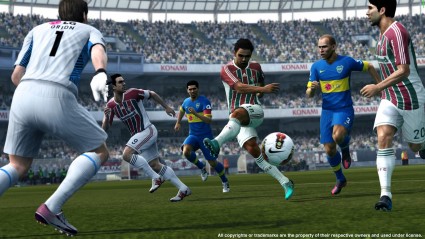
Samba stars
Match making is quick and easy in the standard exhibition games, with you never having to wait too long for a match to be made and the action to get underway. Out on the pitch the game plays just as well as it does offline. This allows for some superb matches as both sides can spread the ball around and build their attacks in true Barcelona style.
The icing on the cake, though, is the Master League Online. Put simply, Master League is a brilliant game mode that grabs you from the off, and it works superbly in an Online environment. If you haven’t experienced this before, you start with the default list of players regardless of your club, and need to earn money through playing and winning games and tournaments against other human-controlled teams.
Players can then be purchased with values being set by the community. Each player has a base value determined by his overall ratings, but this then has a slider applied depending on how many teams sign the player. This then means that you can gain or lose on a player by his popularity in the real world, and it adds another level to the game as you try to find those little gems that others haven’t to give your team a boost at a bargain price.
Single matches will get you up and running and give you a solid income, but to be really successful you need to win some tournaments. These come around regularly with various different levels available and some that require certain criteria to be met before entry. Once in you will have a period of time (usually sixty minutes) to play preliminary matches. To qualify for the full tournament and the big winnings you must score enough points over a three game stretch. Fortunately the preliminary matches do not stop once you’ve played three, so if you lose early on you can keep trying to get the wins and your last three matches when the clock stops will be counted.
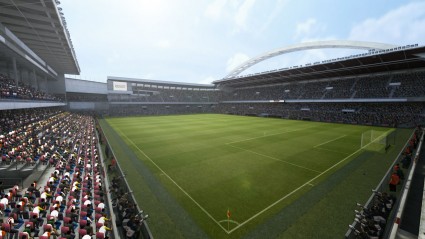
Can you come and do my lawn too?
My only criticism for the online play of PES 2013 is that we don’t have the quick taunts assigned to the buttons we’ve had in the past, so you can’t quickly post a message when you go 3-0 up. Boooooo!
Some of the crowd are on the pitch
When you first load PES 2013 you’d be forgiven for thinking the game hadn’t moved on much from last year. The main menu has an almost identical look to its predecessor, and both the sound and the static graphics bear little or no real improvement. However, dig deeper and you will see that this is a truly stunning representation of the beautiful game.
Sure, there are aspects that still need work, such as the cut-scenes in the two main single player modes (which are as basic as anything you’re likely to see in the bargain titles on XBLA); or the commentary, which can be fairly vague and repetitive. Likewise, there are aspects that don’t carry the same depth as others in the genre such as the Become a Legend mode. The detail in the visuals also aren’t quite at the same level as some of this generation’s biggest titles.
However, I am hard pushed to think of any other franchise, on any platform, in any genre that has progressed as much as PES has this year. Without wanting to undersell what was a very good version of the game last year, PES 2013 has not just raised the bar; it has set a new standard in football games where it matters most: on the pitch. If you have even the slightest affection for the sport or sports games in general, you simply have to:
Platforms: PC, PS3, Xbox 360 | Tagged Football, Konami, Master League, PC, Pes, PS3, Soccer, Winning Eleven, Xbox 360



